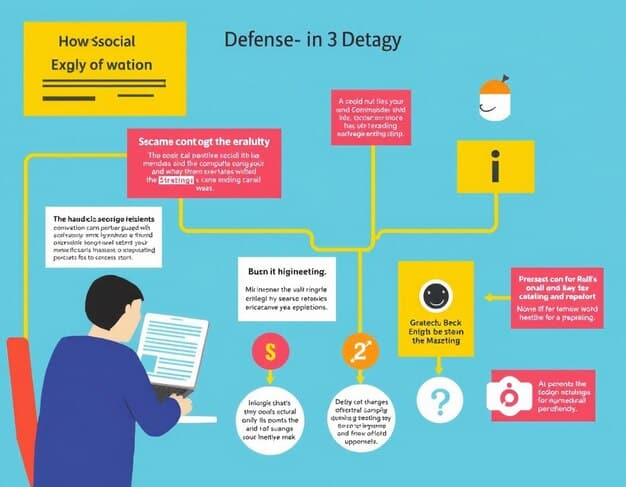Incident Response Plan: A Step-by-Step Guide

An Incident Response Plan (IRP) is a comprehensive framework that outlines the steps an organization should take when facing a cybersecurity breach, including detection, analysis, containment, eradication, recovery, and post-incident activity to minimize damage and prevent future occurrences.
In today’s digital landscape, cybersecurity threats are constantly evolving, making it crucial for organizations to have a solid plan in place. An Incident Response Plan: A Step-by-Step Guide to Handling Cybersecurity Breaches is your blueprint for navigating the complexities of a cyberattack, minimizing damage, and ensuring business continuity.
Why You Need an Incident Response Plan
Cybersecurity breaches can cripple a business, leading to financial losses, reputational damage, and legal liabilities. An incident response plan isn’t just a good idea; it’s a necessity. It provides a structured approach to handling incidents, ensuring a rapid and effective response.
Without a clear plan, organizations often react haphazardly, leading to further complications and increased costs. An IRP empowers your team to act decisively, minimizing the impact of a cyberattack.
The Cost of Inaction
Failing to have an incident response plan can be extremely costly. Consider the potential downtime, data loss, regulatory fines, and customer attrition. These factors can quickly add up, jeopardizing the long-term viability of your business.
Companies with documented incident response plans recover more quickly and experience lower financial losses compared to those without a plan.
Benefits of a Well-Defined IRP
- Reduced Downtime: A swift response minimizes the disruption to business operations.
- Minimized Damage: Containing the breach quickly prevents further data loss and system compromise.
- Improved Compliance: Demonstrates to regulators and customers that you take security seriously.
- Enhanced Reputation: Shows stakeholders you are prepared to handle incidents responsibly.

In essence, an Incident Response Plan is your organization’s first line of defense when faced with a cyberattack.
Key Components of an Incident Response Plan
A comprehensive Incident Response Plan comprises several essential elements. Each component plays a vital role in ensuring an effective and coordinated response to security incidents.
From establishing clear roles and responsibilities to defining communication protocols, these components work together to minimize damage and facilitate a swift recovery.
Incident Response Team
At the heart of every effective IRP is a dedicated incident response team. This team should consist of individuals from various departments, including IT, legal, communications, and management.
Each member of the team should have clearly defined roles and responsibilities, ensuring a coordinated and efficient response.
Communication Plan
- Internal Communication: Establish channels for communication within the incident response team.
- External Communication: Define protocols for communicating with stakeholders, customers, and law enforcement.
- Transparency: Ensure clear and consistent messaging to maintain trust and manage expectations.
Incident Classification
Not all incidents are created equal. Your IRP should include a system for classifying incidents based on their severity and impact.
This classification system will help prioritize response efforts and allocate resources effectively. Common classifications include low, medium, and high severity incidents.
Technical Procedures
Your Incident Response Plan should clearly outline the technical procedures for detecting, analyzing, containing, eradicating, and recovering from incidents. These procedures should be well-documented and regularly updated.
Without these key components, it becomes impossible to have a clear roadmap on how to respond to any incident that comes along the way.
Step-by-Step Guide to Creating an IRP
Developing an effective Incident Response Plan involves a series of steps, from planning and preparation to testing and maintenance. Each step is crucial for ensuring your IRP is comprehensive and up-to-date.
Let’s walk through the process of building an IRP that will strengthen your organization’s cybersecurity posture.
Step 1: Planning and Preparation
The first step is to establish a clear scope and objectives for your IRP. Identify key stakeholders, define roles and responsibilities, and gather the necessary resources.
This initial phase sets the foundation for a successful incident response program.
Step 2: Detection and Analysis
- Monitoring Tools: Implement security monitoring tools to detect suspicious activity.
- Log Analysis: Regularly review logs to identify potential incidents.
- Threat Intelligence: Stay informed about the latest threats and vulnerabilities.
Step 3: Containment
Once an incident is detected, the next step is to contain the damage. This may involve isolating affected systems, disabling compromised accounts, and implementing temporary security measures.
Containment is essential for preventing the incident from spreading further.
Step 4: Eradication
Eradication involves removing the root cause of the incident. This may require patching vulnerabilities, removing malware, and restoring systems to a secure state. It does not just mean fixing the issue, but also stopping the cause of the issue from ever happening again.
Ensure the eradication process is thorough to prevent reinfection.

Step 5: Recovery
Recovery involves restoring affected systems and data to normal operations. This may require restoring from backups, rebuilding systems, and verifying the integrity of data.
The recovery process should be carefully planned and executed to minimize downtime.
Step 6: Post-Incident Activity
After the incident is resolved, conduct a thorough post-incident review. Identify lessons learned, update your IRP, and implement additional security measures.
Post-incident activity is crucial for preventing future incidents and improving your overall security posture.
Testing and Maintaining Your IRP
An Incident Response Plan is not a one-time document; it requires regular testing and maintenance. This section emphasizes the importance of keeping your IRP up-to-date and ensuring its effectiveness through simulated scenarios.
Regular testing helps identify gaps and weaknesses in your plan, allowing you to refine your procedures and improve your team’s readiness.
Simulated Incident Scenarios
Conduct regular simulations to test your IRP. These simulations should mimic real-world incidents and involve all members of the incident response team.
Simulations can reveal unexpected challenges and improve coordination among team members. Running these simulations are important to show possible outcomes ahead of time.
Regular Updates
Cybersecurity threats are constantly evolving, so your IRP must be regularly updated to reflect the latest threats and vulnerabilities.
Keep your plan current by reviewing it at least annually or more frequently if there are significant changes to your IT environment.
Feedback and Improvement
Solicit feedback from your incident response team and other stakeholders to identify areas for improvement in your IRP.
Use this feedback to refine your procedures and enhance your overall security posture. Your team’s feedback can make or break processes.
Training
You can not do it alone. Provide regular training to your incident response team to ensure they are familiar with the IRP and their roles and responsibilities.
Well-trained teams are more effective at responding to incidents quickly and efficiently.
Tools and Technologies to Support Your IRP
Implementing an Incident Response Plan requires the right tools and technologies to facilitate detection, analysis, containment, and eradication. This part will highlight some of the essential tools that can empower your incident response team.
From security information and event management (SIEM) systems to endpoint detection and response (EDR) solutions, these tools can significantly enhance your ability to respond to security incidents.
Security Information and Event Management (SIEM)
SIEM systems aggregate and analyze security logs from various sources, providing real-time visibility into potential incidents.
SIEM tools can help you detect suspicious activity, identify anomalies, and prioritize response efforts.
Endpoint Detection and Response (EDR)
EDR solutions monitor endpoints for malicious activity, providing advanced threat detection and response capabilities.
EDR tools can help you identify and contain threats before they cause significant damage.
Network Intrusion Detection Systems (NIDS)
- Real-Time Monitoring: NIDS monitor network traffic for suspicious patterns and anomalies.
- Alerting: Provide alerts when potential incidents are detected.
- Forensic Analysis: Assist in analyzing network traffic to understand the scope and impact of an incident.
Vulnerability Scanners
Vulnerability scanners identify weaknesses in your systems and applications, allowing you to address them before they are exploited.
Remember to schedule regular scans to stay on top of any issues that come along the way.
Incident Response Platforms (IRP)
IRP tools automate and streamline the incident response process, providing a centralized platform for managing incidents.
These platforms can help you coordinate response efforts, track progress, and ensure compliance.
| Key Point | Brief Description |
|---|---|
| 🛡️ Planning and Preparation | Establish scope, objectives, and key stakeholders. |
| 🚨 Detection and Analysis | Use monitoring tools and logs to identify incidents. |
| 🛑 Containment | Isolate affected systems to prevent further spread. |
| ✅ Testing and Maintenance | Regularly test and update the IRP to stay effective. |
Frequently Asked Questions (FAQ)
▼
The primary goal is to minimize the damage caused by a cybersecurity incident. This involves quickly detecting, containing, and eradicating the threat to restore normal operations.
▼
The team should include members from IT, legal, communications, and management. This ensures a comprehensive and coordinated response from all relevant departments.
▼
You should test your IRP at least annually or more frequently if there are significant changes. Regular updates are crucial to address new threats and vulnerabilities.
▼
Critical tools include SIEM systems, EDR solutions, NIDS, vulnerability scanners, and incident response platforms. These tools help in detecting, analyzing, and responding to incidents efficiently.
▼
Post-incident activity helps identify lessons learned and prevent future incidents. It involves conducting a thorough review and implementing additional security measures based on the findings.
Conclusion
A well-crafted Incident Response Plan is an essential component of any organization’s cybersecurity strategy. By following this step-by-step guide, you can create a robust plan that minimizes damage, ensures business continuity, and enhances your overall security posture.





